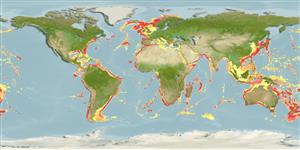Elasmobranchii (tubarões e raias) (sharks and rays) >
Squaliformes (Sleeper and dogfish sharks) >
Dalatiidae (Sleeper sharks)
Etymology: Dalatias: Etymology not explained nor evident. A few online sources suggest Dalatias is derived from dalos (Gr.), torch or firebrand, but nothing in Rafinesque’s description supports this interpretation. Interestingly, D. licha is bioluminescent, a fact that was discovered and resported only recently and was certainly unknown to Rafinesque and other early naturalists. See: Mallefet J., D. W. Stevens, and L. Duchatelet. 2021. Bioluminescence of the largest luminous vertebrate, the kitefin shark, Dalatias licha: first insights and comparative aspects. Frontiers in Marine Science 8 (article 633582): 1-13. (See ETYFish); licha: Latinization of “La Liche” as reported by Broussonet (1780), an old French word for this shark, possibly from from the Occitan lecha or lec, meaning “glutton”. (See ETYFish).
More on author: Bonnaterre.
Environment: milieu / climate zone / depth range / distribution range
Ecologia
marinhas batidemersal; intervalo de profundidade 37 - 1800 m (Ref. 247), usually 300 - 600 m (Ref. 247). Deep-water; 72°N - 56°S, 98°W - 153°W
Western Atlantic: Georges Bank and northern Gulf of Mexico. Eastern Atlantic: Iceland (Ref. 12462), Scotland, and Irish Atlantic slope to Morocco, western Mediterranean, Madeira to Cameroon. Western Indian Ocean: Mozambique and South Africa. Western Pacific: Japan, Australia, and New Zealand. Central Pacific: Hawaii.
Comprimento de primeira maturação / Tamanho / Peso / Idade
Maturity: Lm 139.0, range 117 - 159 cm
Max length : 182 cm TL macho/indeterminado; (Ref. 10717)
Espinhos dorsais (total) : 0; Espinhos anais: 0. Moderately sized, short- and blunt-snouted shark with two almost equal-sized dorsal fins; papillose thick lips; small slender-cusped upper teeth and very large lower teeth with erect triangular serrated cusps and distal blades; first dorsal fin on back with its origin behind the pectoral rear tips and its base closer to the pectoral base than the pelvic fins; and caudal fin with the ventral lobe not expanded (Ref. 247). Dark grey-brown to black; trailing edges of fins translucent (Ref. 26346).
Found on outer continental and insular shelves and slopes (Ref. 247). Mainly found on or near the bottom but readily occurs well off the substrate (Ref. 247, 58302). Often pelagic (Ref. 58302). Found singly or in small schools (Ref. 6871). Feeds mainly on deepwater bony fish, but also skates, other sharks (etmopterids in Ref. 123656), cephalopods and crustaceans (Ref. 5578). This bioluminescent shark (currently the largest luminous vertebrate) emit light ventrally to counterilluminate which might be used to illuminate the ocean floor while searching/hunting for prey; or to stealthily approach prey, using counterillumination camouflage, before striking fast when it is close enough (Ref. 123656). Ovoviviparous (Ref. 205), with 10-20 young born at 30-42 cm (Ref. 26346). Used for its squalene liver oil, leather and meat, as well as for fishmeal (Ref. 6871).
Ovoviviparous (Ref. 247). 10-20 young born at 30-42 cm (Ref. 26346); 10-16 young born at 30 cm TL (Ref.58048). Distinct pairing with embrace (Ref. 205).
Compagno, L.J.V., 1984. FAO Species Catalogue. Vol. 4. Sharks of the world. An annotated and illustrated catalogue of shark species known to date. Part 1 - Hexanchiformes to Lamniformes. FAO Fish. Synop. 125(4/1):1-249. Rome, FAO. (Ref. 247)
Status na Lista Vermelha da UICN (Ref. 130435)
Ameaça para os humanos
Harmless
Uso pelos humanos
Pescarias: pouco comercial
Ferramentas
Relatórios especiais
Baixar XML
Fontes da internet
Estimates based on models
Preferred temperature (Ref.
123201): 2.5 - 14.3, mean 5.3 °C (based on 3093 cells).
Índice de diversidade filogenética (Ref.
82804): PD
50 = 1.0020 [Uniqueness, from 0.5 = low to 2.0 = high].
Bayesian length-weight: a=0.00372 (0.00141 - 0.00976), b=3.12 (2.89 - 3.35), in cm total length, based on LWR estimates for this (Sub)family-body shape (Ref.
93245).
Nível Trófico (Ref.
69278): 4.2 ±0.4 se; based on diet studies.
Resiliência (Ref.
120179): Baixo, tempo mínimo de duplicação da população 4,5 - 14 anos (Fec=10-20).
Prior r = 0.27, 95% CL = 0.18 - 0.40, Based on 1 data-limited stock assessment.
Fishing Vulnerability (Ref.
59153): High to very high vulnerability (65 of 100).
Climate Vulnerability (Ref.
125649): Moderate vulnerability (38 of 100).
Nutrients (Ref.
124155): Calcium = 6.01 [1.29, 31.29] mg/100g; Iron = 0.325 [0.075, 1.053] mg/100g; Protein = 19.3 [17.4, 21.2] %; Omega3 = 0.303 [0.107, 0.998] g/100g; Selenium = 21.6 [5.9, 65.2] μg/100g; VitaminA = 6.5 [1.4, 30.4] μg/100g; Zinc = 0.214 [0.104, 0.400] mg/100g (wet weight);
